A Binocular Comet in Time for Christmas – C/2014 Q2 Lovejoy.
Shinning at close to magnitude +7 comet C/2014 Q2 Lovejoy is within easy reach of binoculars (10×50) as well as telescopes with apertures as small as 3-inches. The 5th comet discovered by Australian Terry Lovejoy on August 17th with a Celestron C-8 fitted with a CCD camera from his observatory in Brisbane, Australia, it has an orbital period of about 11 500 years with an orbit inclined steeply to the plane of the Solar System (80.3º). Now that the Moon is past full the comet is well placed for observation in the early evening moving around 3º every 24 hours. Presently in the constellation Puppis it moves into Columba (Dec 27) and then Eridanus by January next year as it approaches perihelion on January 30th. Comet Lovejoy is expected to brighten to possibly 5th magnitude as it approaches Earth, making it a naked eye apparition from a dark sky site. On December 28th / 29th the comet passes within ½º of the 8th magnitude globular cluster M79, a great opportunity for astrophotographers.
Follow this link for more information and detailed instructions on how to find the comet :
——————————————————————————————————————————-
Report from Tim Cooper – 18th January 2015
Observer Tim Cooper, Bredell
2015 January 18.75 UT
m1 = 3.9
Coma diameter = 12’
DC = 6
No clouds but significant haze, despite this comet easily discerned with naked eye, in 16×50 binoculars slightly smaller and more condensed, and slightly brighter than previous. Stars used for brightness estimate HIP 13209, 14838, 17499 (Elektra) and 17573 (Maia). The star HIP 14762 (mag 7.2) was within the confines of the coma and was accounted for in the estimate of m1.
——————————————————————————————————————————-
Report from Tim Cooper – 11th January 2015
Observer Tim Cooper, Bredell
2015 January 11.81 UT
m1 = 4.2
Coma diameter = 16’
DC=5-6
Observed during a gap between clouds, conditions not optimal, probably resulted in comet showing slightly smaller with less outer coma visible.
Nevertheless, the comet seems also very slightly fainter than previous.
——————————————————————————————————————————-
Report from Tim Cooper – 7th January 2015
After another massive storm this afternoon, clouds cleared to allow observation before moonrise. Comet Lovejoy is an easy naked eye object !
Observation as follows:
Tim Cooper, Bredell, South Africa
2015 January 7.75 UT
16 x 50 binoculars
m1 = 4.1,
Coma diameter = 0.3°,
DC=5.
Comet is larger and brighter than previous, but less condensed. Appears as a large diffuse circular object, prominent central condensation surrounded by considerable outer coma and hint of definite point-like condensation in the centre. No tail visible. Comet is easily visible to the naked eye.
——————————————————————————————————————————-
Report from Tim Cooper – 30th December 2014
Observer Tim Cooper
2014 December 30.80 UT
m1 = 5.0
Coma diameter = 10 arc minutes
Degree of condensation = 6/
Description, 16×50 binoculars, large, bright, spherical, appears like a bright globular cluster, inner coma bright and quite condensed, surrounded by prominent outer nebulosity, DC=6-7.
In 16” very bright point at centre of coma, stellar in appearance, not visible in binoculars.
No tail visible in binoculars, but then conditions probably prevented visibility. Under clearer conditions the comet would no doubt have been visible to the naked eye.
Conditions, 70% moon nearby surrounded by thin haze.
Brightness estimated using 1 Lep, HIP23554, HIP24927, HIP23430.
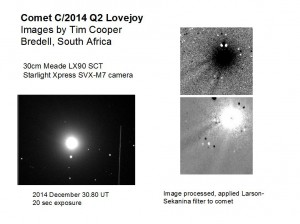
Images of comet C/2014 Q2 Lovejoy
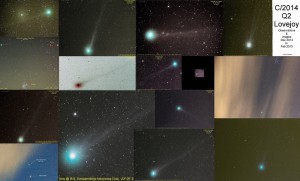
Images of Lovejoy Q2 by Kos Coronaios – Dec 2014 to Jan 2015

Image of Lovejoy Q2 by Kos Coronaios 6 February 2015
Comment from Kos : 8 x 30 second, 300mm lens, north is towards the bottom right hand corner. Comet was about 10 deg. above the horizon and will soon be lost for southern hemisphere observers
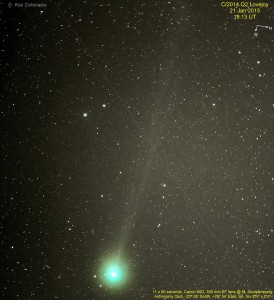
Image of Lovejoy Q2 by Kos Coronaios 21 January 2015
(No darks, offset or flats used for this one. The two bright stars above the comet are 49 Arietis (left) and SAO 75696 (right), +5.9 & +6.6 respectively.)
57 Second Exposure
ISO 1600
Stacked In Deep-Sky Stacker …
Processed In Photo Plus X4
12-inch Dobsonian Reflector Telescope
Dobtorial Tracking Platform
Canon 1100DSLR Camera

Image of Lovejoy Q2 by Kos Coronaios 13 January 2015
Q2 13th January, seen with the naked eye from a light polluted sky (Louis Trichardt, town), estimate magnitude +4 (naked eye). Observations (10:20 SAST from home), 8-inch f10, 26 mm eyepiece (77x mag), coma diameter .23º, DC 6. Comet appears as a large diffuse object in the eyepiece, filling at least 1/3rd of the field of view, with a bright central coma.

Image of Lovejoy Q2 by Kos Coronaios 11 January 2015
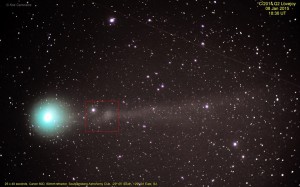
Image of Lovejoy Q2 by Kos Coronaios 8 January 2015
showing the tail disconnection event
Comment from Kos Coronaios:
Last decent evening was on the 8th and I managed to capture a disconnection event. Seeing conditions were average with no change in the comet as far as naked eye visibility. Did confirm that no tail was visible with 12 x 50 binoculars, so I was mistaken in thinking that I’d seen one. I also took the 10-inch f4 (26 mm eyepiece) out, for a change and managed to view the comet for a very short period of time (max 5 minutes) due to cloud. No time for any observations but again no visible tail. It was a lovely sight in that rich field telescope.
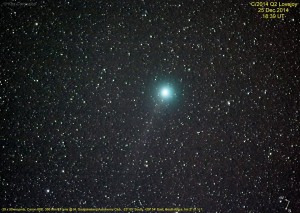
Image of Lovejoy Q2 by Kos Coronaios 25 Dec 2014
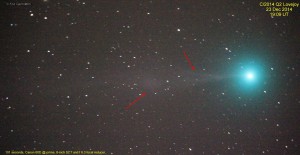
Image of Lovejoy Q2 by Kos Coronaios 23 Dec 2014
showing a tail disconnection event
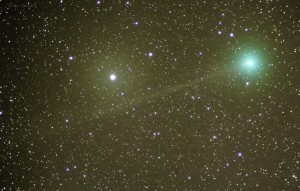
Image of Lovejoy Q2 by Kos Coronaios 20 Dec 2014
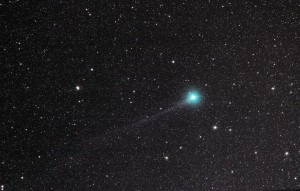
Image of Lovejoy Q2 by Kos Coronaios 18 Dec 2014
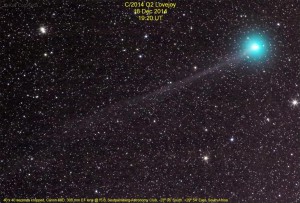
Cropped Image of Lovejoy Q2 by Kos Coronaios 18 Dec 2014
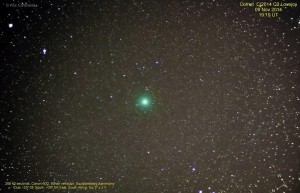
Image of Lovejoy Q2 by Kos Coronaios 10 Dec 2014
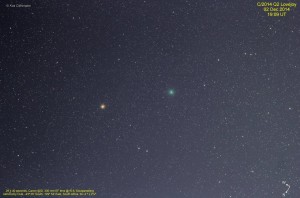
Image of Lovejoy Q2 by Kos Coronaios 2 Dec 2014
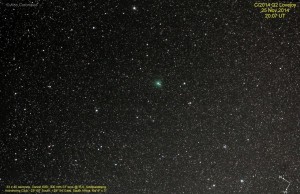
Image of Lovejoy Q2 by Kos Coronaios 25 Nov 2014

